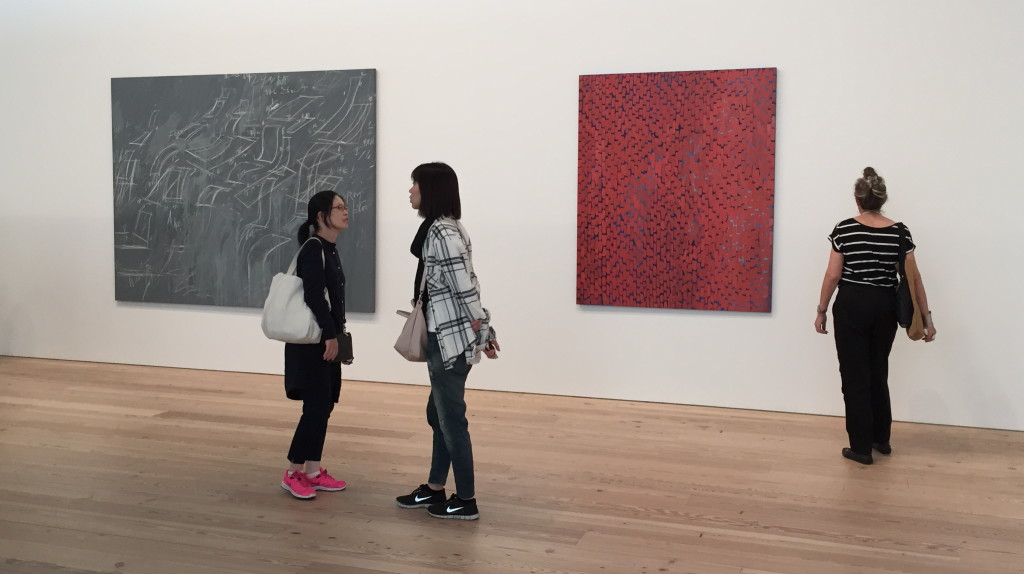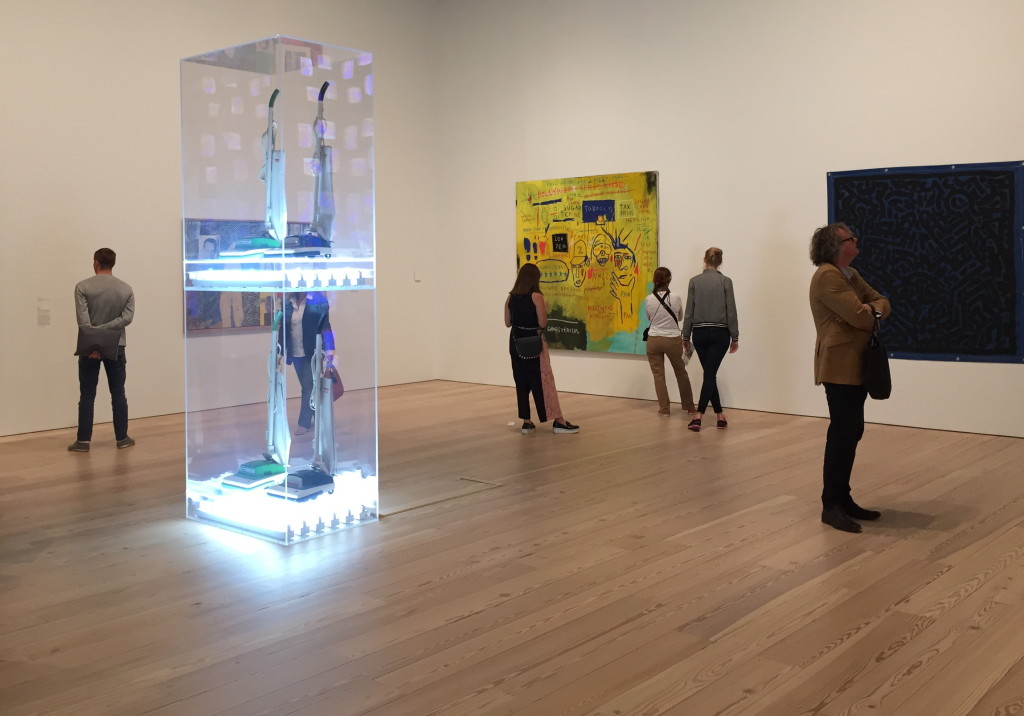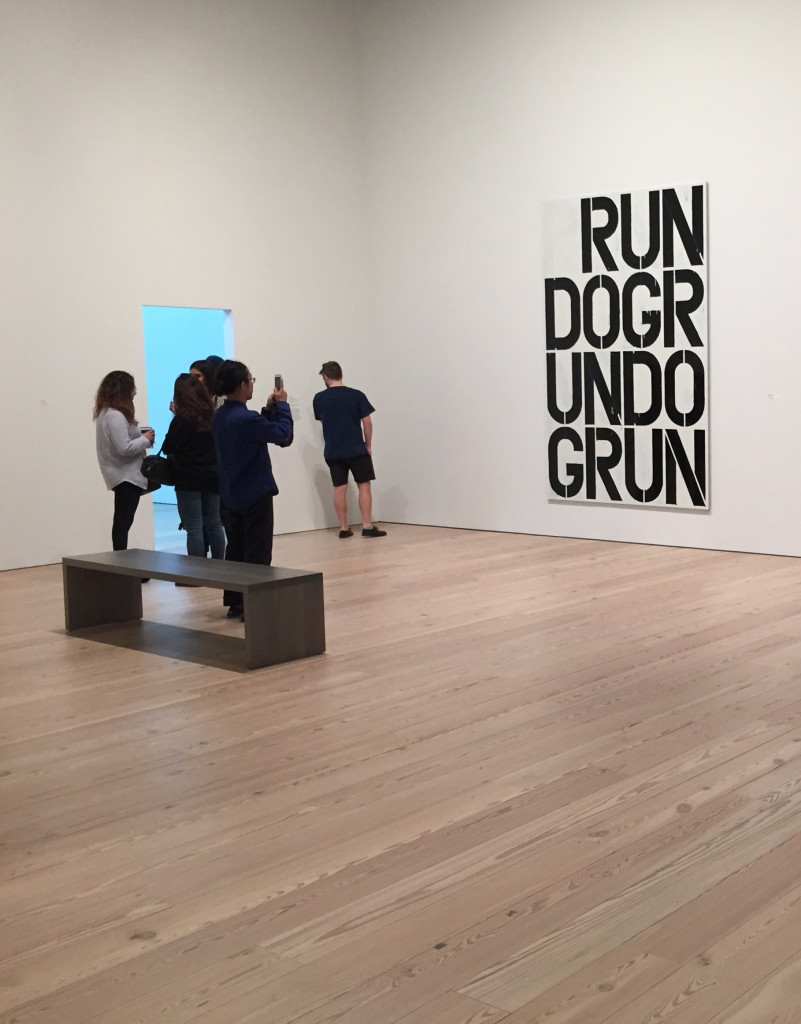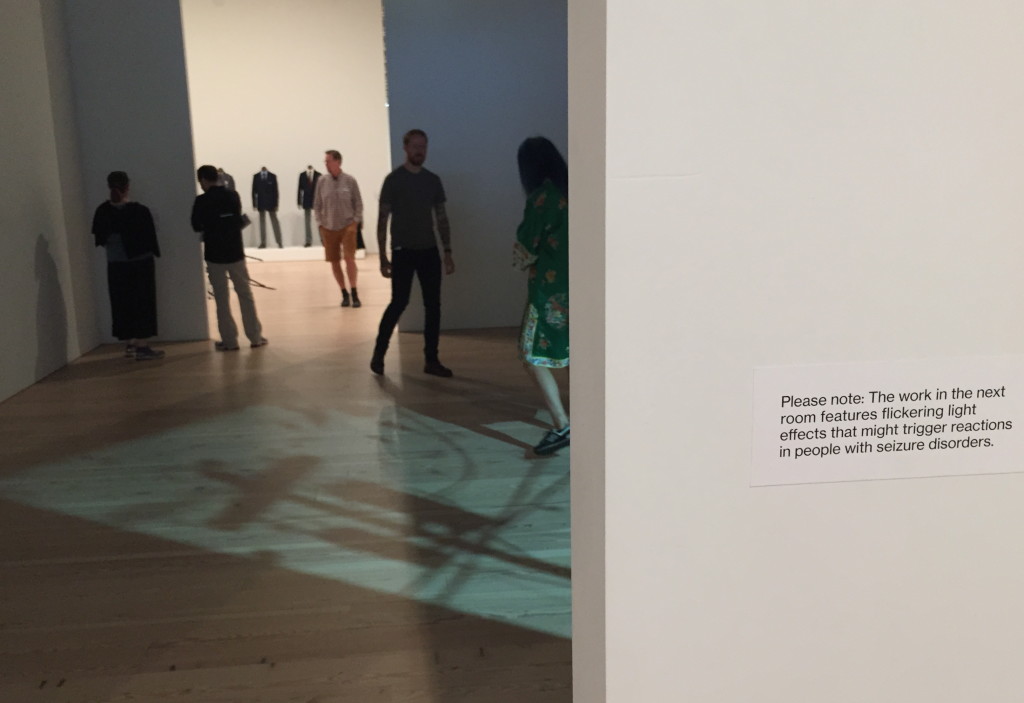September 5th, 2016
The 2015 reopening of the Renwick Gallery in Washington, DC, was celebrated with an exhibition featuring the work of nine contemporary artists. Five women and four men created site-specific installations that occupied and transformed the museum’s refurbished gallery spaces. Over a period of 8 months, visitors found themselves immersed in wonders indeed. Official photographs of the event can seen at the online gallery, here. Below are photos of three of the nine rooms that I took during my visit in April, 2016. Descriptions of the artists’ works quoted below are borrowed from the Renwick Gallery’s wall texts, found here.
Maya Lin, Folding the Chesapeake (installation, 2015)
“Growing up in Ohio in the 1960s, Lin watched her father participate in the fledgling studio glass movement then gathering steam in nearby Toledo. The marbles used in this installation are the same industrial fiberglass product Henry Huan Lin and other glass-blowing pioneers experimented with then, which were soon abandoned by artists as technical knowledge matured. Folding the Chesapeake marks their first use by Maya Lin and a new chapter in her decades-long investigation of natural wonders. By shaping rivers, fields, canyons, and mountains within the museum, Lin shifts our attention to their outdoor counterparts, sharpening our focus on the need for their conservation.”
.
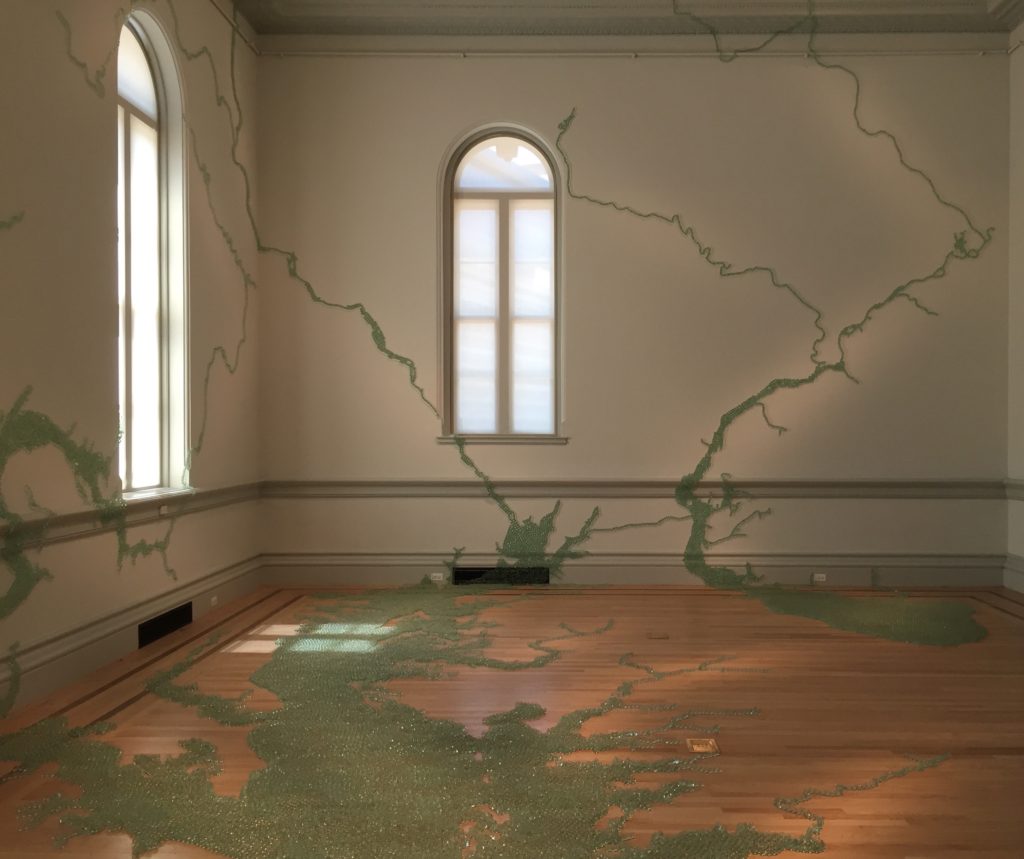 .
.
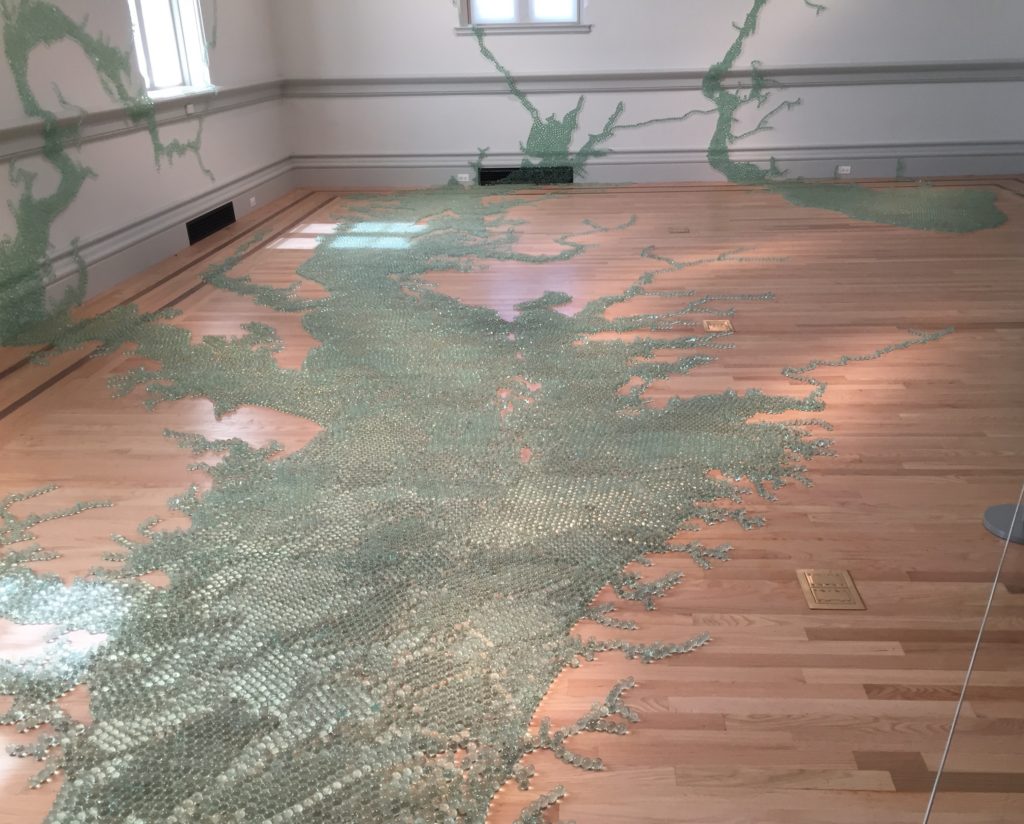 .
.
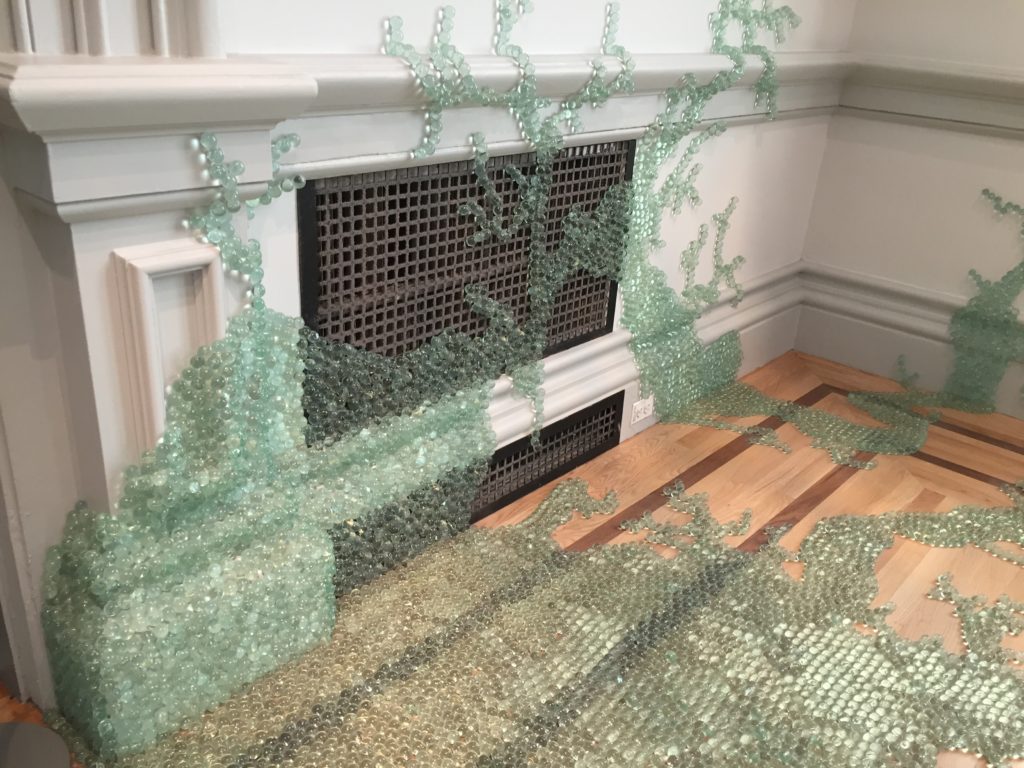 .
.
Gabriel Dawe, Plexus A1 (installation, 2015)
“Dawe’s architecturally scaled weavings are often mistaken for fleeting rays of light. It is an appropriate trick of the eye, as the artist was inspired to use thread in this fashion by memories of the skies above Mexico City and East Texas, his childhood and current homes, respectively. The material and vivid colors also recall the embroideries everywhere in production during Dawe’s upbringing.”
.
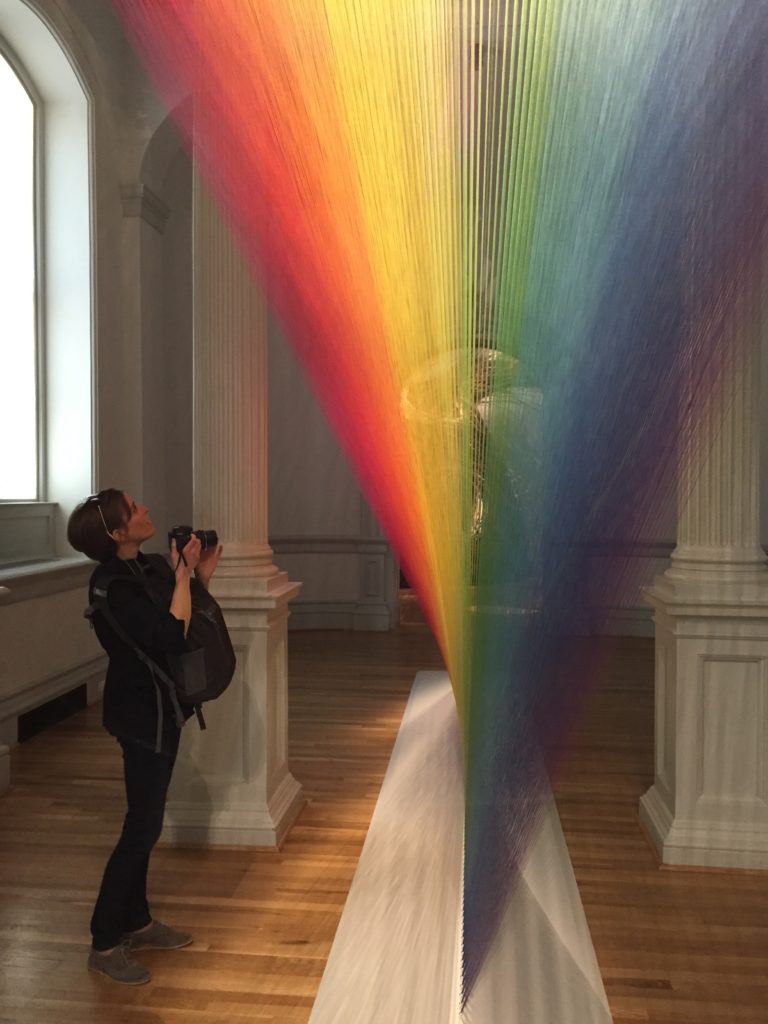 .
.
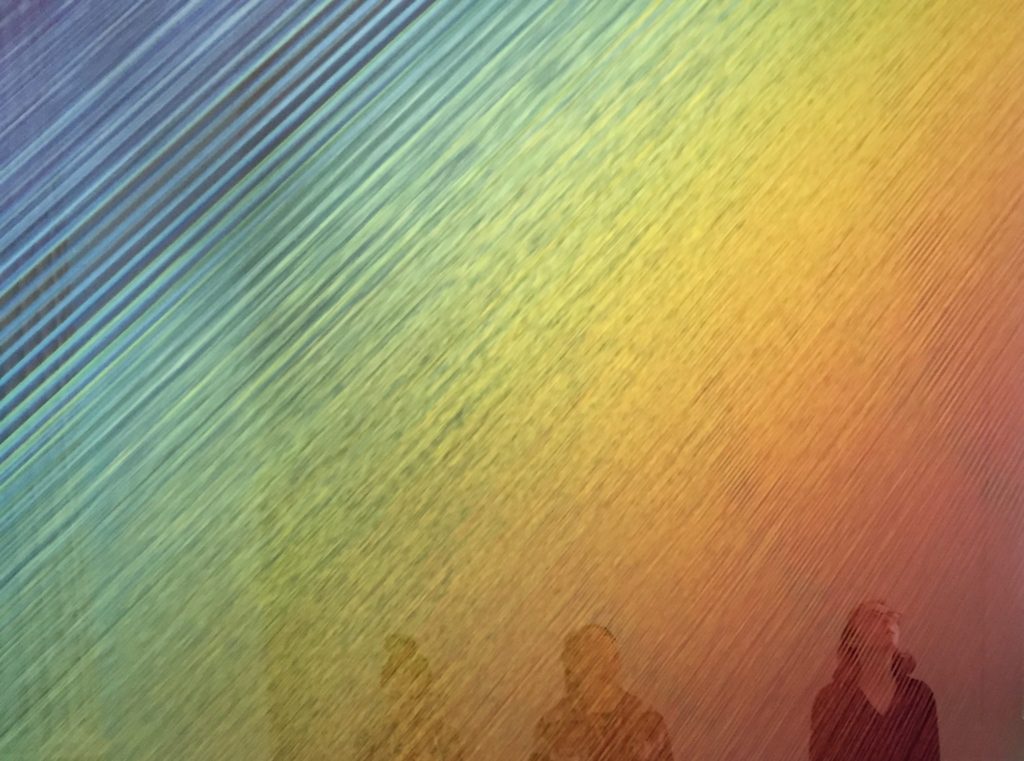 .
.
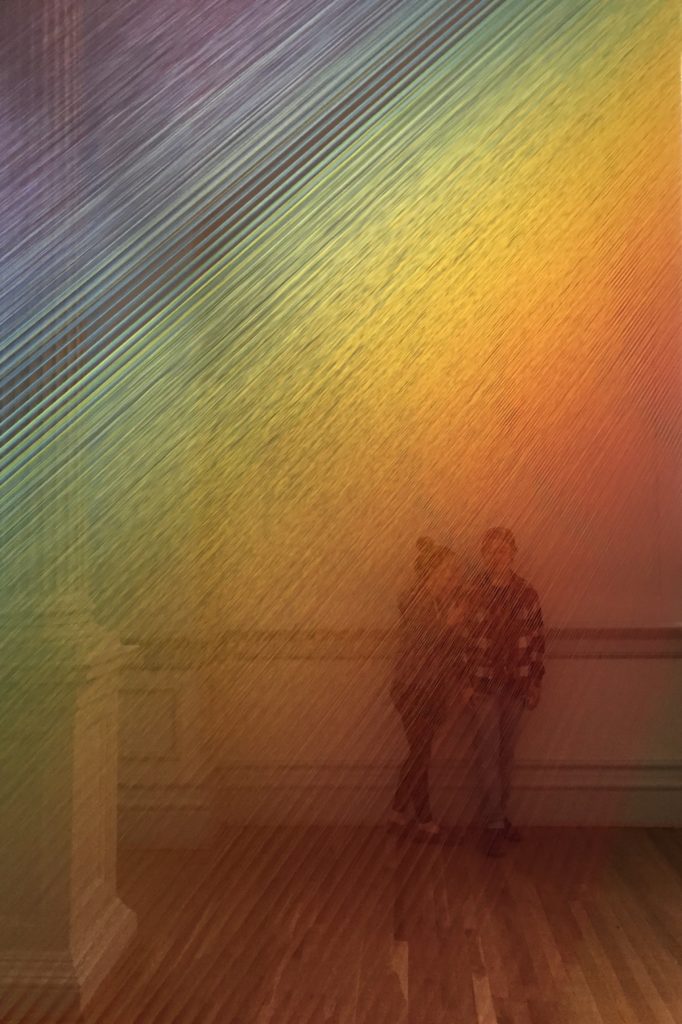 .
.
Tara Donovan, Untitled , 2014, © Tara Donovan, courtesy of Pace Gallery
“Employing mundane materials such as toothpicks, straws, Styrofoam cups, scotch tape, and index cards, Donovan gathers up the things we think we know, transforming the familiar into the unrecognizable through overwhelming accumulation. The resulting enigmatic landscapes force us to wonder just what it is we are looking at and how to respond. The mystery, and the potential for any material in her hands to capture it, prompts us to pay better attention to our surroundings, permitting the everyday to catch us up again.”
.
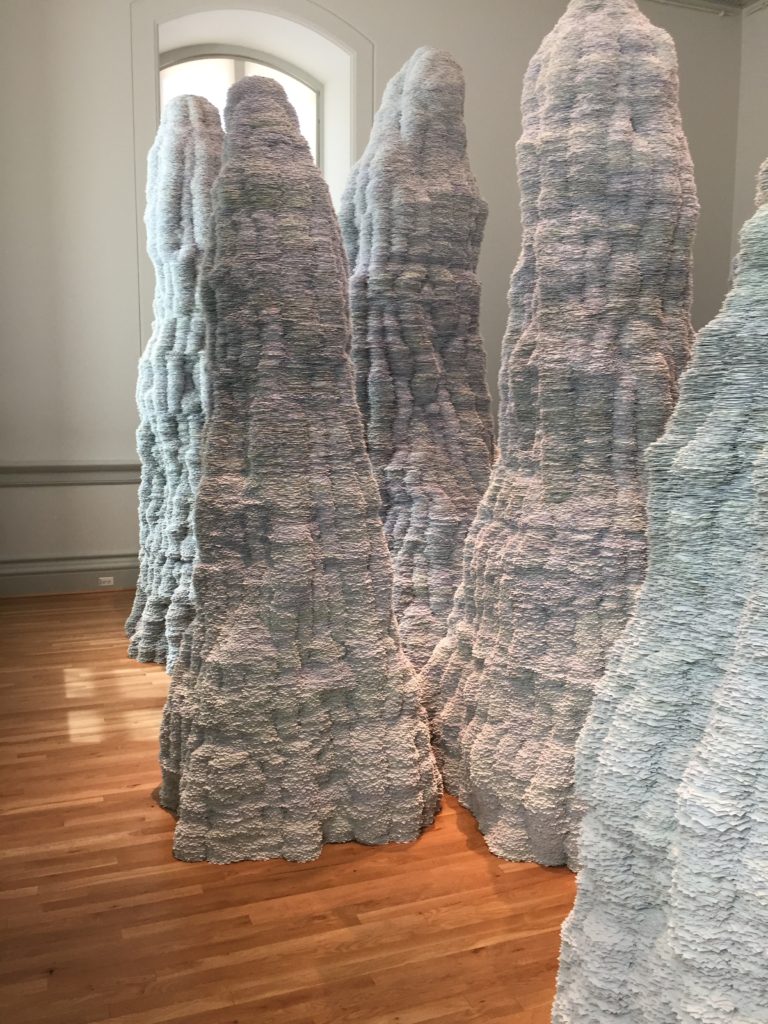
.
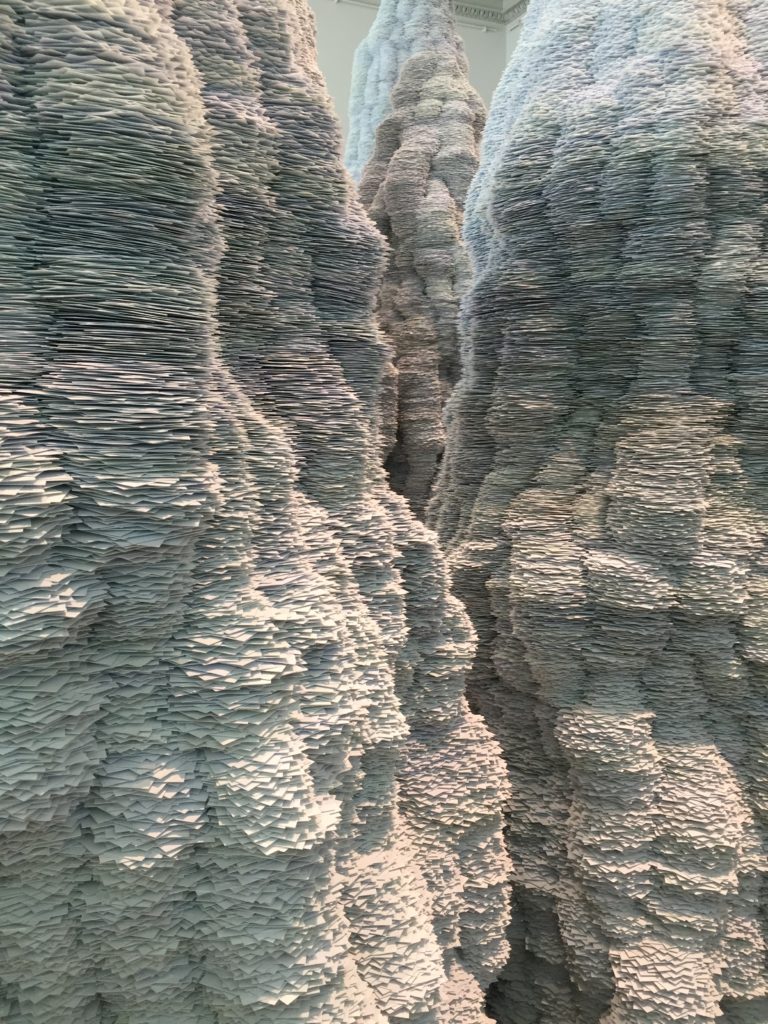 .
.
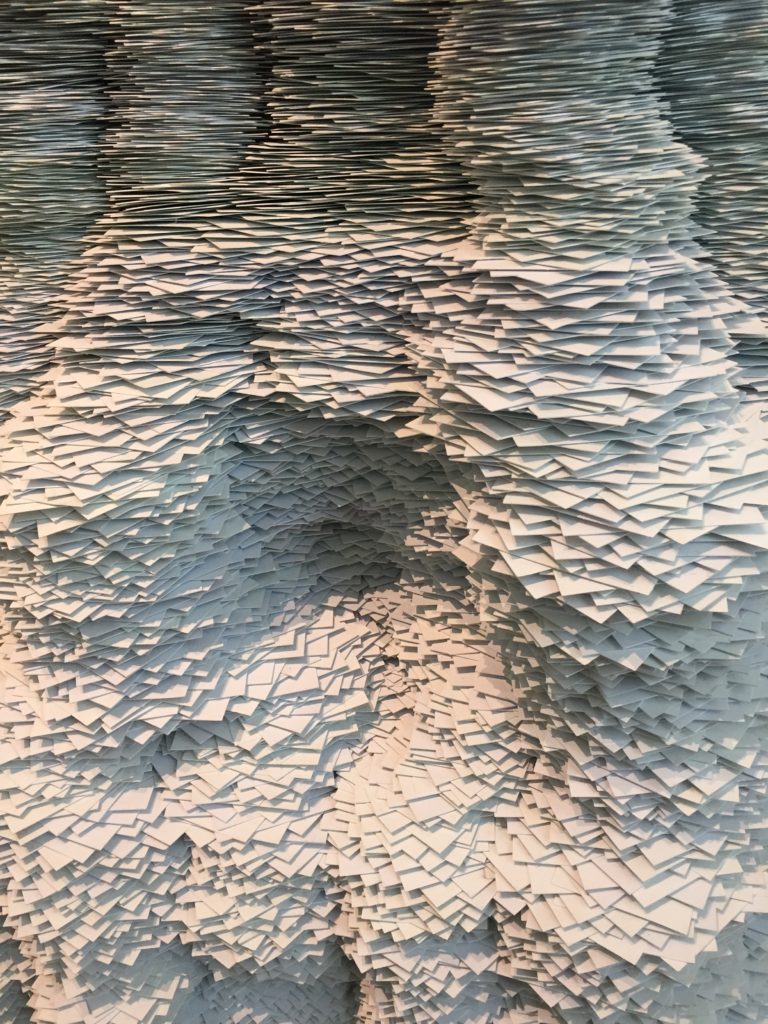
.
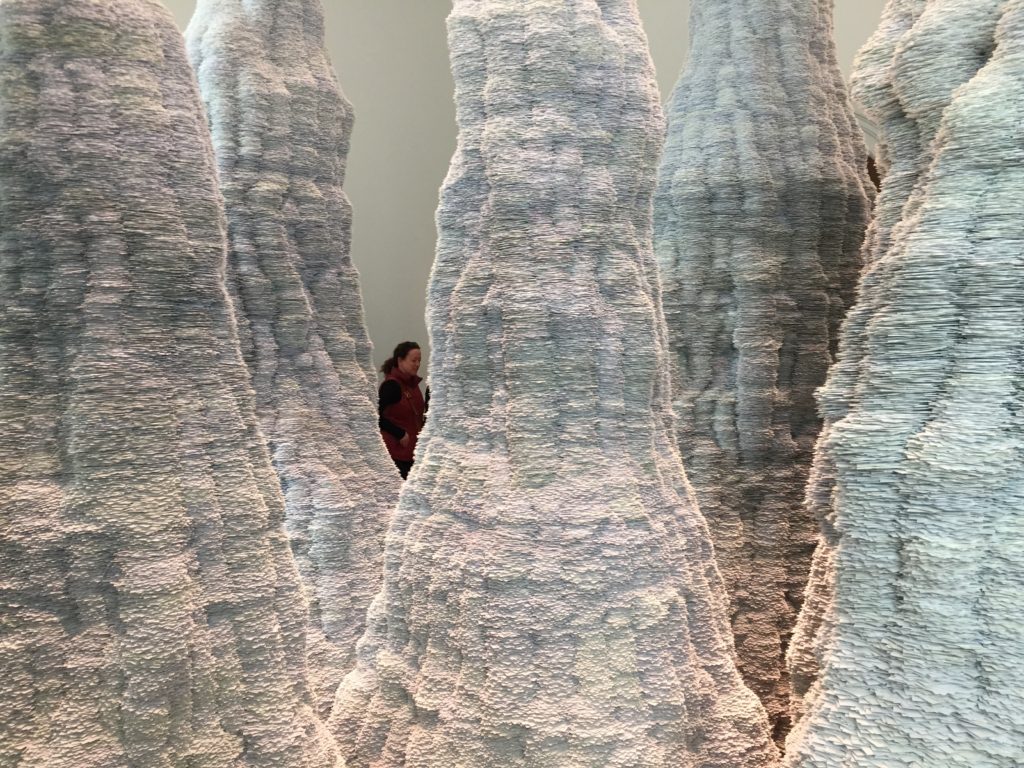 .
.
Tags: Chesapeake Bay, Gabriel Dawe, Gallery, Maya Lin, Philadelphia, Renwick, Smithsonian Museum of American Art, Tara Donavan
Posted in Architecture, Art, Culture, Nature, Photos | No Comments »
January 30th, 2016
.
Photos of Glover Park yesterday at dusk: a hand-printed sign guarding a shoveled-out parking space, and a sunset view from the edge of the park.
.

.

.
More examples of parking-space “dibs” signs, made by city folks in DC and Philadelphia as they dug their way out of the blizzard of 2016, can be found here.
Tags: blizzard, blizzard of 2016, dibs signs, dug out parking spots, dusk, Glover Park, man, man vs nature, nature, Parking Space, shoveled, sign, snow, Snow Law: You Do Not Park Here, snowmageddan, snowpocalypse, snowzilla, sunset, warning sign, Washington DC
Posted in Humor, Nature, Photos | No Comments »
December 23rd, 2015
.
The time: December 22, 2015, 10:48 am. The setting: Intersection of Pennsylvania Ave. and 18th Street NW, Washington, DC.
.

.
In the wake of a light rain shower, two spots of colorful efflorescence appear on the surface of the asphalt.
.

.
Are these not astronomical images, the one suggesting a spiral galaxy and the other an eclipsed star?
.

.

.
More about oil blooms on wet streets, here. The phenomenon–known in physics as oil film interference–is exhaustively explained here. Check out this brilliant Instagram shot of what looks like a furry jellyfish floating through space.
For a previous post of mine discussing another instance when mother nature displays her art on man’s concrete, click here.
Tags: oil blooms, oil film interference, Pennsylvania Avenue, Washington DC
Posted in Nature, Photos | No Comments »
December 20th, 2015
.
Earlier this evening while visiting the National Gallery of Art I saw how smartly the museum has integrated a few of the thousands of American works of art it acquired last year from the defunct Corcoran Gallery of Art (founded 1869, dissolved 2014).
For example, the pinnacle of the Corcoran’s collection of Hudson River School paintings, Niagara (1857) by Frederick Edwin Church (1826-1900), has been given pride of place in this room at the National Gallery of Art — where it has become the painting people invariably stop to admire:
.

.

.
(For a memento of how the painting looked when it used to hang at the Corcoran Gallery of Art, click here.)
A strength of the Corcoran museum, and an element that in my personal experience over the years turned that institution into an enlightening museum of American history as well as a fine museum of American art, was its collection of genre paintings — depictions of everyday life in our nation. Here are four gems belonging to that category, newly huddled in a corner where they are adding vitality to visitors’ experience of the National Gallery of Art.
.

.
The large canvas on the left is a picture I made certain to pay my respects to on dozens of visits (starting in the 1970s) to its former home. Titled A Pastoral Visit, it was painted in 1881 by Richard Norris Brooke (1847-1920). A powerful narrative executed with controlled sentimentality, the painting succeeds in a way that Norman Rockwell — our most beloved genre artist — all too often does not.
On the right side of the photo, the three other paintings that came to the NGA from the Corcoran share Brooke’s ambition and achievement. But these are scenes of more modest scale, with a tone unique to each artist. From left to right: The Tough Story–Scene in a Country Tavern (1837) by William Sidney Mount (1807-1868); Waiting for the Stage (1851) by Richard Caton Woodville (1825-1855); and Leisure and Labor (1858) by Frank Blackwell Mayer (1827-1899), an early political commentary conveyed via posture and dress (while beautifully composed and painted, too).
Now I look forward to the NGA hanging on its walls additional, equally bold works from the Corcoran trove. Two suggestions, if I may: The Longshoreman’s Noon (1879) by John George Brown, and Nearing the Issue at the Cockpit (1879) by Horace Bonham.
.
Tags: 1837, 1857, 1858, 1879, 1881, A Pastoral Visit, Corcoran Gallery of Art, Corcoran Museum, Frank Blackwell Meyer, Frederick Edwin Church, Horace Bonham, John George Brown, Leisure and Labor, National Gallery of Art, Nearing the Issue at the Cockpit, Niagara, Norman Rockwell, Richard Caton Woodville, Richard Norris Brooke, The Longshoreman's Noon, The Tough Story - Scene in a Country Tavern, Waiting for the Stage, William Sidney Mount
Posted in Art, Culture, Photos, Politics | No Comments »
December 12th, 2015
.
Just returned from an evening tour of the White House, now decorated for the Christmas season.
The entrance to the East Wing is guarded by stalwart Penguins — volunteers, one imagines, from Santa’s polar region.
.

.
Once inside, your journey down a hallway turns magical under a canopy of paper snowflakes:
.

.
When you reach the White House proper, a succession of public rooms greets you. One of these is the Green Room, which displays a spectrum of American art, including paintings by John Marin and Jacob Lawrence (for a daytime photo of the Green Room, click here):
.

.

.
Of the many Christmas trees on display, this one in the East Room is my candidate for best (neither the fellow in the lower left nor the one on the back wall expressed an opinion):
.

.
Tags: Christmas, Christmas tree, decorated, decorations, Evening, Jacob Lawrence, John Marin, Laura Bush, penguins, Snowflakes, Tour, White House
Posted in Architecture, Art, Photos | 2 Comments »
November 21st, 2015
The so-called War on Christmas may be a fiction, but there is no doubting that contemporary Americans, even those you would expect to know better, are much less familiar with Christian iconography than in the past. I previously posted an idle observation on this subject, here.
A new example came to my attention this week, in an auction catalog posted online by an auction house in Connecticut. In the listings for the sale there is an item labeled, “TOMAS PENNING (1905-1982) CARVED CROSS.” It’s accompanied by several photos and the following description:
“Carved slate, marked NR above figure, Dimensions: H 36″ x W 22.5″ Condition: good”
.

.
Here’s one of the photos showing the segment above the figure:

.
One can suppose the cataloguer mentioned that two letters, NR, appear above the figure for some reason beyond mere diligence (it’s standard cataloguing practice to indicate for the benefit of remote bidders who can’t examine the object in person, all of the marks, initials, dates and other inscriptions found on it). But why mention just the N and the R? Did the cataloguer not see within the rectangle the “I” before and the “I” after the letters NR? Was he or she not familiar with the four letter inscription, INRI, that appears in representations of the crucified Jesus? Was there no one around who knew the significance of the acronym INRI? That it comes from the Latin phrase ‘Iesus Nazarenus Rex Iudaeorum’ — ‘Jesus of Nazareth, King of the Jews’? That according to the crucifixion story in the Bible (John 19:19), this was a notice Pontius Pilate posted over the head of Jesus as he lay dying on the cross? That this imagery has been a part of our cultural conversation spanning centuries?
Two unforgettable examples:
.

Andrea Mantegna (1431-1506), The Crucifixion, 1459 (detail)
.

Emile Nolde (1867-1956), Crucifixion, 1912
.
Tags: Andrea Mantegna, Christ, Crucifixion, Emile Nolde, Iesus Nazarenus Rex Iudaeorum, INRI, Jesus, Jesus of Nazareth, John 19:19, King of the Jews, Mantegna, Nolde, Tomas Penning, visual literacy
Posted in Art, Culture, Photos | No Comments »
November 1st, 2015
.
For Halloween 2015 in Glover Park, grave markers were on front lawns everywhere. The most original group of tombstone R.I.P.’s:
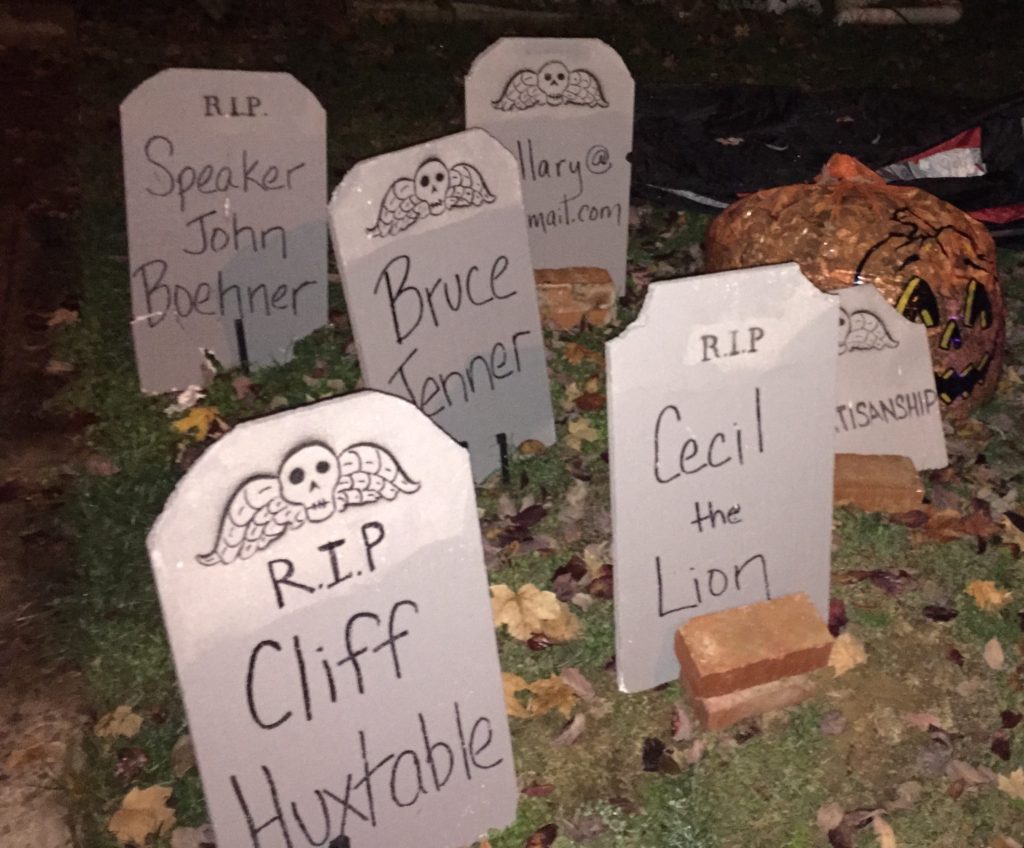 (Note: That’s “hillary@gmail.com” in the center background, “Bipartisanship” on the right.)
(Note: That’s “hillary@gmail.com” in the center background, “Bipartisanship” on the right.)
.
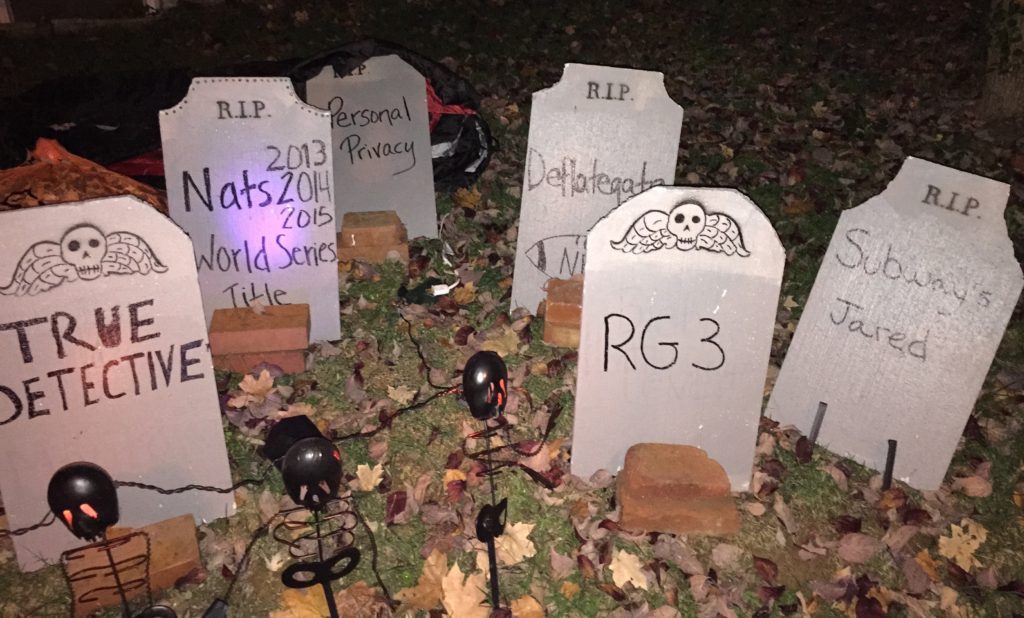
.
Tags: 2015, Bipartisanship, Bruce Jenner, Cecil the Lion, Cliff Huxtable, Deflategate, Glover Park, grave markers, grave stones, Halloween, Halloween 2015, hillary@gmail.com, Nats, R.I.P., Rest in Peace, RG3, RIP, Speaker John Boehner, Subway's Jared, tomb stones
Posted in Uncategorized | No Comments »
October 4th, 2015
Being drawn to people who look like ourselves is a common phenomenon firmly based in science. A number of recent articles provide an explanation, here, here, and here. When finding another person attractive, your standards will relate to aspects of your own appearance that you know best — your face, the shape of your head and body, your coloring, etc.
Does this “like attracted to like” phenomenon apply beyond our evaluation of other people?
I think so.
It’s often remarked how the pets people choose, especially dogs, look like their owners. From anecdotal evidence, and my practice as an armchair psychologist, I believe a strong case can be made that this gravitational pull extends even further — to inanimate things that catch our eye in the material world. I’ve posted about this subject once before, here. Yesterday brought to my sight another example.
At Costco there was an indoor display of pumpkins. It was huge, while maybe not yooge. When autumn arrives, who among us — whether a person or a cartoon character — can resist the spell of ripe pumpkins? The scene was worthy of being photographed and so I snapped several pictures of it.
Here’s one:
.
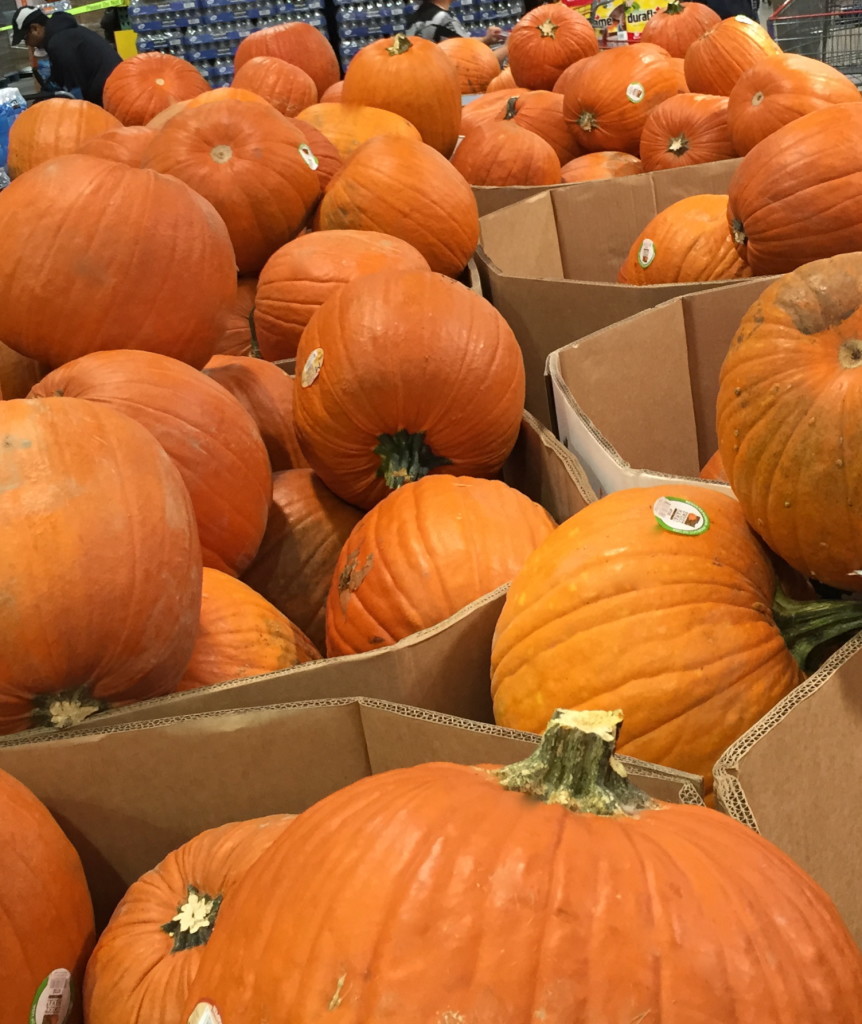
.
Later at home, while looking through the full set of photos, one picture jumped out. It includes a woman who, amid the crowd attracted to this harvest of pumpkins, I remember reacted to the display with special delight:
.
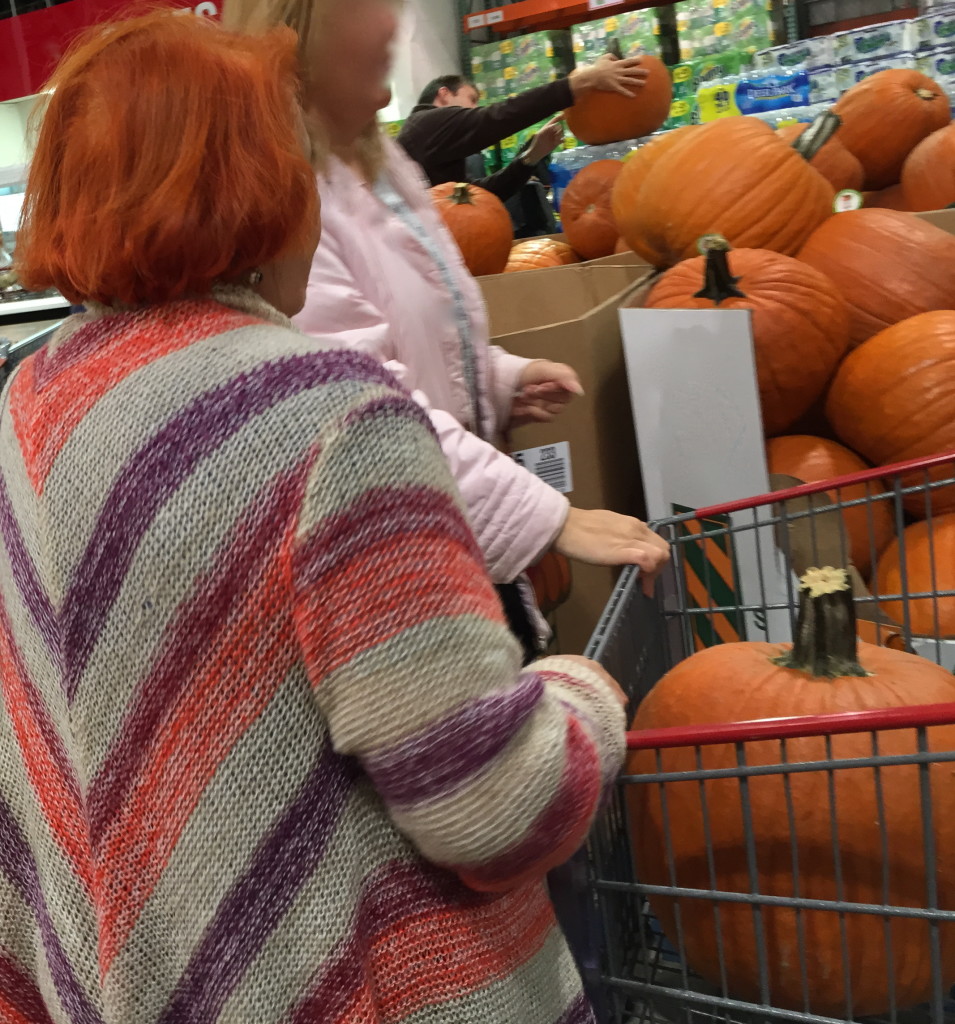
.
I rest my case.
.
Tags: Costco, hair, like attracted to like, orange, psychology, Psychology Today, pumpkin, pumpkins
Posted in Dogs, Humor, Photos | No Comments »
July 26th, 2015
.
Washington, DC, July 2, 2015, 2:06:45pm.
.
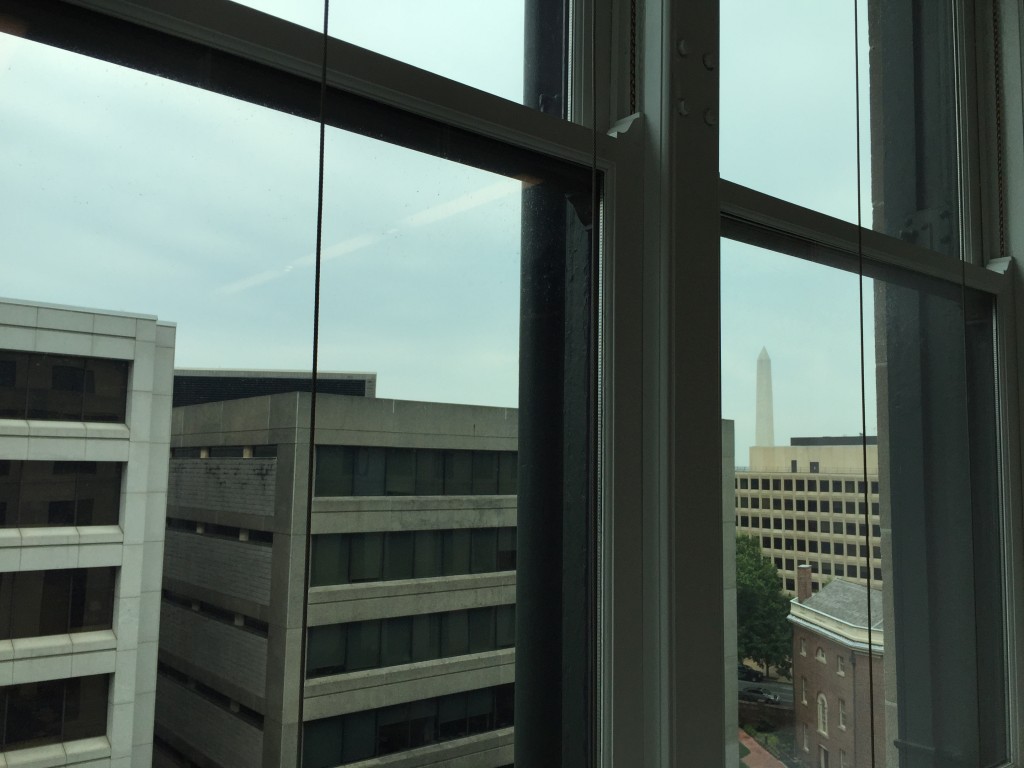
.
Tags: DC, Octagon, Octagon House, Octagon Museum, The Octagon House, Washington, Washington DC, Washington Monument
Posted in Architecture, Photos | No Comments »
































